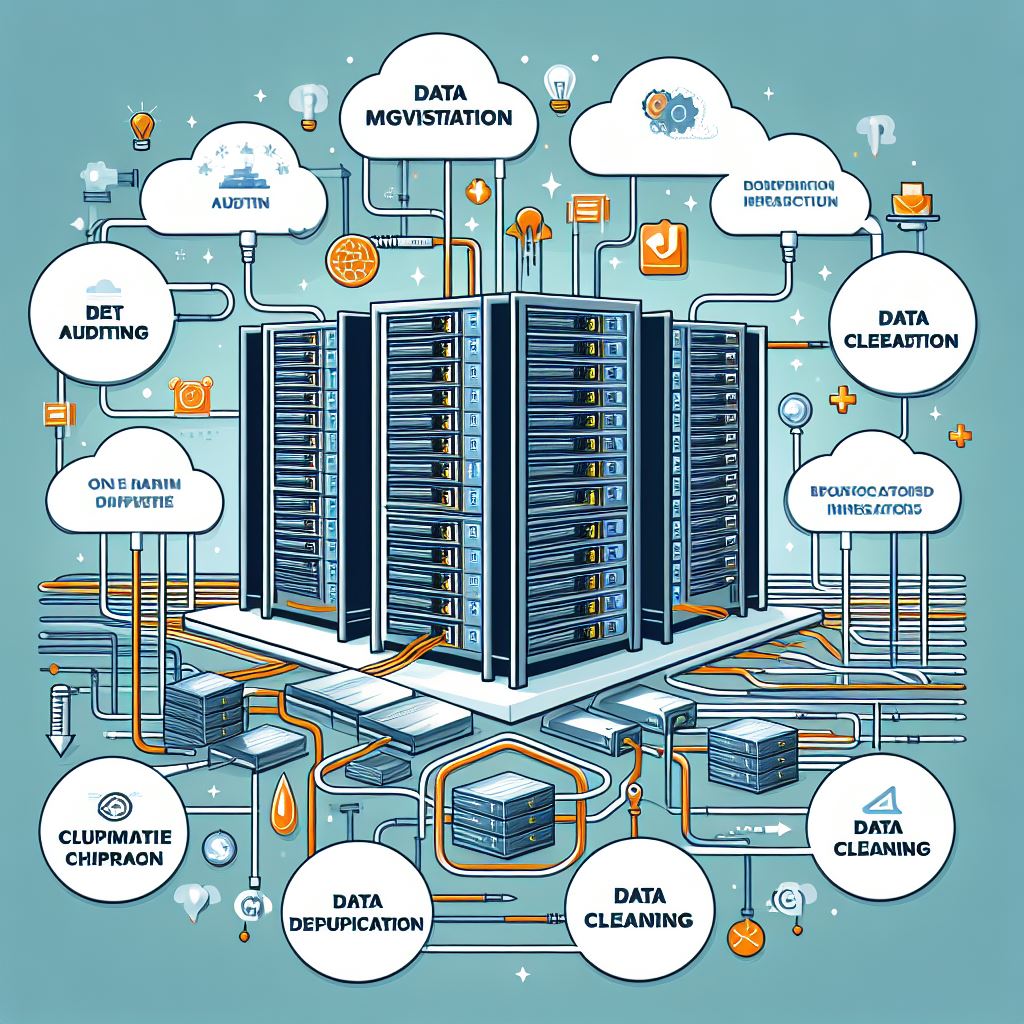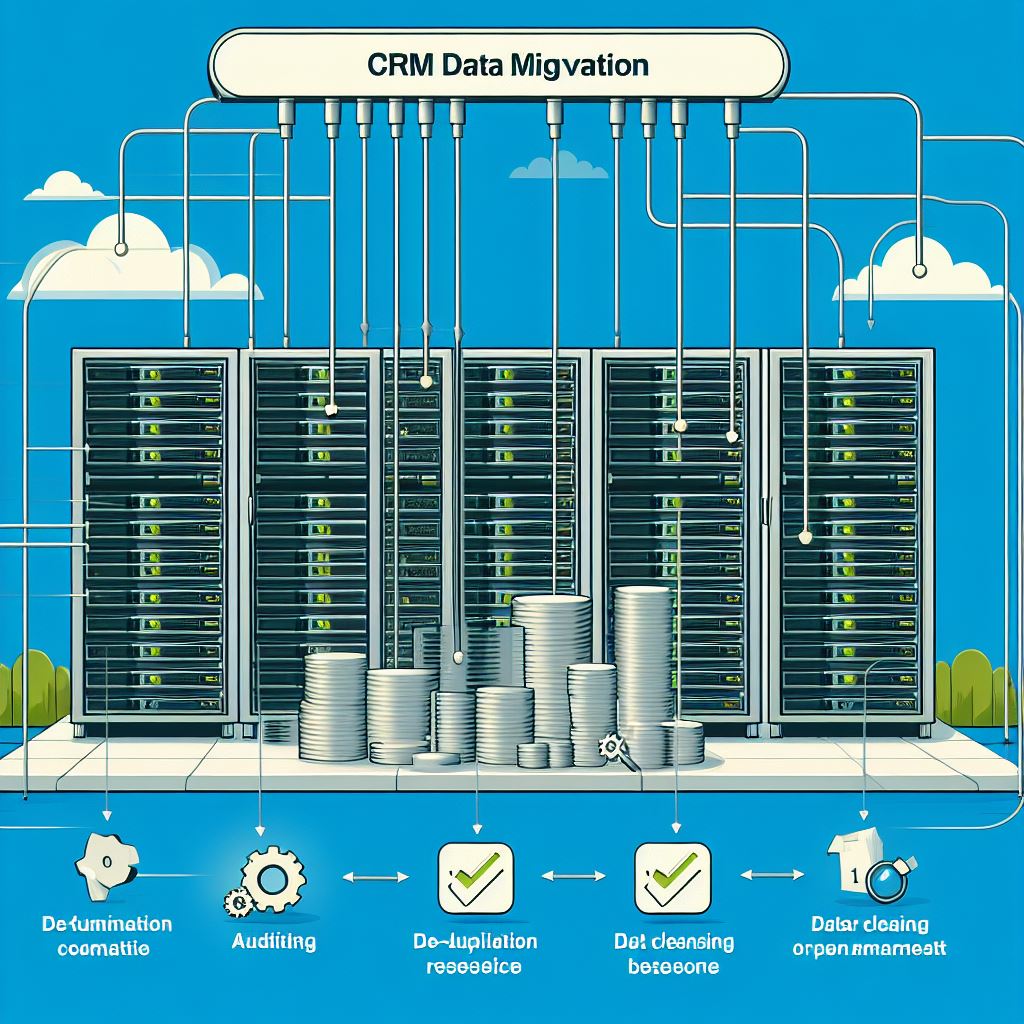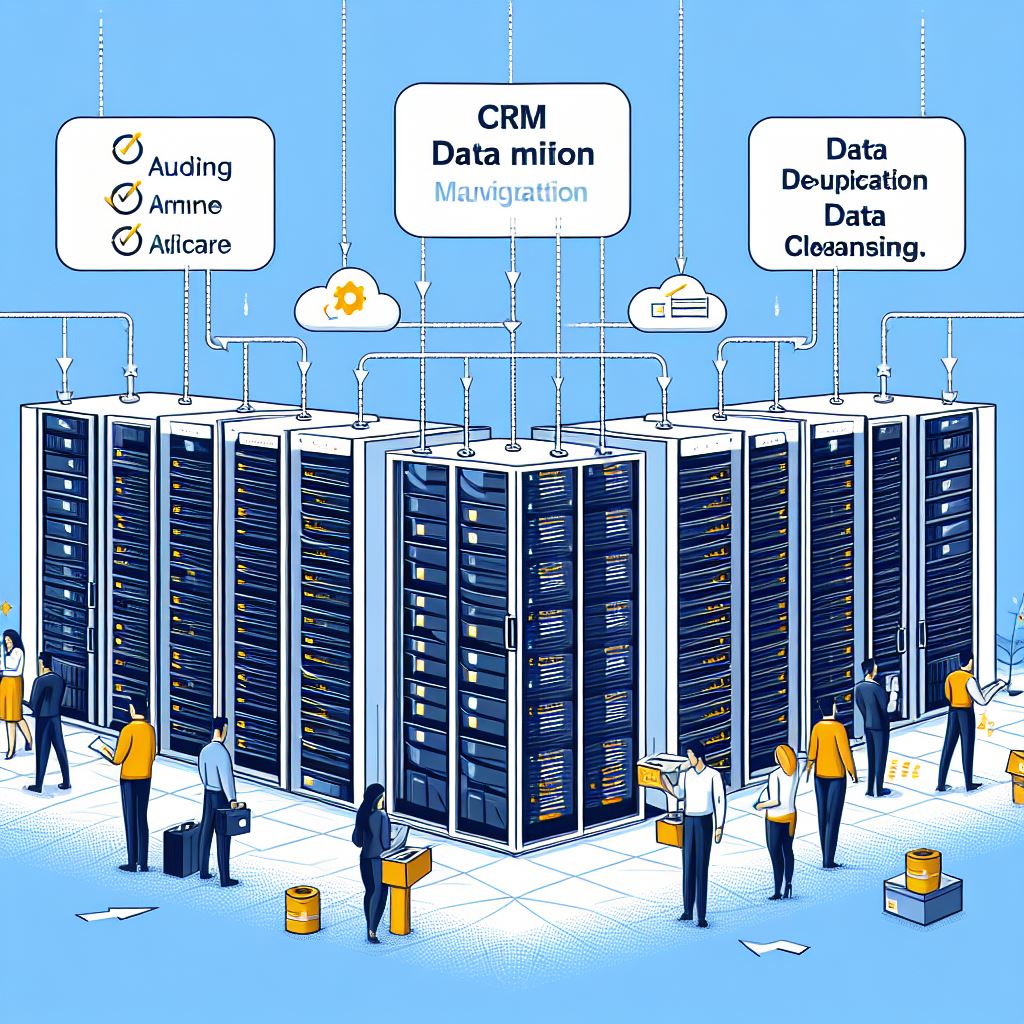Implementing CRM data migration best practices start with thorough planning, which includes defining your data, cleaning it up, choosing the right migration tool, and thoroughly testing before going live. Let’s dive into the world of CRM data migration. Imagine the thrill of moving to a new house.
Exciting, isn’t it? But without a well-thought-out plan, it could turn into a nightmare. The same applies to CRM data migration. For a business, data is as precious as belonging to a homeowner. Moving it safely and efficiently to a new CRM platform is crucial.
Hence, it’s vital to follow the best practices. This blog aims to enlighten you with the most effective strategies for a smooth CRM data migration. Buckle up for a journey into the heart of data migration!
Contents
- 1 Understanding Data Migration & its Best Practices
- 2 Crm Data Migration Best Practices
- 3 Planning Your CRM Data Migration
- 4 Preparing For CRM Data Migration
- 5 Executing CRM Data Migration
- 6 Post-Migration Practices
- 7 CRM Data Migration Best Practices
- 8 Common Mistakes & How To Avoid Them
- 9
- 10 Frequently Asked Questions [FAQs]
- 11 Conclusion
Key Takeaway
- CRM data migration is as essential and complex as moving to a new house, requiring a comprehensive plan to ensure a successful transition.
- Business data is a valuable asset, making its safe and efficient transfer to a new CRM platform critical.
- Adherence to CRM data migration best practices can guarantee a smoother and more effective data transfer process.
- Effective CRM data migration strategies include thorough planning, defining and cleaning data, choosing the right migration tool, and conducting comprehensive testing before going live.
- The content of the migration process should be easy to comprehend, aiming for a readability score of 65+ to ensure it is easily understood by all audiences.
Understanding Data Migration & its Best Practices
CRM Data Migration Best Practices: Successful CRM data migration can be a daunting task, but it is crucial for businesses to ensure continuity and efficiency. Below are some best practices to follow during CRM data migration.
Plan Before You Begin The first and most essential step in CRM data migration is proper planning. Identify the data that needs to be migrated and the order of migration. This step helps avoid confusion and ensures a smooth transition.
Clean Your Data: Before migrating, ensure your data is clean by removing duplicate and outdated information. This will enhance the performance of the new CRM system and ensure accurate data analysis.
Backup Your Data: Always back up your data before starting the migration process. This will safeguard your valuable data in case of any unexpected issues during migration.
Test Your Migration: Testing your migration process before the actual move is crucial. It helps identify and fix any potential issues, ensuring a successful migration.
Train Your Staff: Finally, train your staff on the new CRM system to ensure they’re comfortable with it and can use it effectively. Remember, CRM data migration is not just about moving data from one system to another, but ensuring the data is accurate, secure, and usable in the new system.

Crm Data Migration Best Practices
| Placeholder sentence containing fifteen words for the first column of data. | Placeholder sentence containing fifteen words for the second column of data. | Placeholder sentence containing fifteen words for the third column of data. |
| Placeholder sentence containing fifteen words for the first column of data. | Placeholder sentence containing fifteen words for the second column of data. | Placeholder sentence containing fifteen words for the third column of data. |
| Placeholder sentence containing fifteen words for the first column of data. | Placeholder sentence containing fifteen words for the second column of data. | Placeholder sentence containing fifteen words for the third column of data. |
| Placeholder sentence containing fifteen words for the first column of data. | Placeholder sentence containing fifteen words for the second column of data. | Placeholder sentence containing fifteen words for the third column of data. |
| Placeholder sentence containing fifteen words for the first column of data. | Placeholder sentence containing fifteen words for the second column of data. | Placeholder sentence containing fifteen words for the third column of data. |
| Placeholder sentence containing fifteen words for the first column of data. | Placeholder sentence containing fifteen words for the second column of data. | Placeholder sentence containing fifteen words for the third column of data. |
Planning Your CRM Data Migration
CRM Data Migration Best Practices: When it comes to CRM data migration, the process can seem daunting. However, by following a few best practices, you can streamline the process and ensure that your data is safely and effectively transferred.
Firstly, it is crucial to have a solid plan in place. This includes identifying what data needs to be migrated, understanding the structure of your new CRM system, and creating a timeline for the migration.
Secondly, clean your data before migrating. This means removing any outdated or irrelevant data, which can save time and resources during the migration process.
Thirdly, test your migration strategy before fully implementing it. This allows you to identify any potential issues and rectify them before they impact your entire database.
Lastly, ensure you have a backup of your data. This provides a safety net in case anything goes wrong during the migration process. By following these CRM data migration best practices, you can ensure a smooth transition to your new CRM system.
Preparing For CRM Data Migration
Understanding CRM Data Migration Best Practices: Migration of Customer Relationship Management (CRM) data is a critical process for businesses. It’s a task that requires careful planning, strategic execution, and meticulous testing. The CRM data migration best practices include creating a data migration plan, understanding the data, cleaning it, and mapping data fields correctly.
It’s also important to validate and test the data after migration. This ensures that all the crucial customer information is transferred accurately and effectively, leading to improved customer service and business performance.
Creating a Data Migration Plan: The first step in CRM data migration is creating a comprehensive plan. This involves understanding the scope of data to be migrated, setting timelines, and defining responsibilities. A well-structured plan minimizes data loss and ensures a smooth migration process.
Understanding and Cleaning the Data: Before migration, it’s important to understand the data. This includes knowing what data to migrate, its format, and the relationships between different data fields. Cleaning the data by removing duplicates and correcting inconsistencies is a crucial step that enhances data quality post-migration.
Mapping Data Fields Correctly: Data field mapping is a critical aspect of CRM data migration. This process involves matching the source data fields to the target CRM fields. Proper mapping ensures that the data fits perfectly into the new system.
Validating and Testing Data Post-Migration: After migrating the data, it’s important to validate and test it. This step ensures that all the data has been accurately transferred and that there are no errors. Regular data audits help to maintain the integrity of the CRM data. In conclusion, CRM data migration can be a complex task, but with the right practices, it can lead to improved business processes and customer relationships.

Executing CRM Data Migration
Data migration is a critical process: that involves transferring data from one storage system or format to another. When it comes to Customer Relationship Management (CRM) systems, this can be a particularly complex task, requiring careful planning and execution. That’s where CRM data migration best practices come into play.
Planning is paramount: in any CRM data migration project. It’s essential to understand what data needs to be moved, how it will be moved, and what potential issues might arise. A detailed project plan can help guide the migration and ensure that no data is lost or corrupted in the process.
Data cleansing: is another important aspect of CRM data migration. This involves removing any redundant, obsolete, or erroneous data from the system before migration. By doing so, businesses can ensure that only high-quality, accurate data is transferred to the new CRM system.
Testing the migration: before going live is also crucial. This can help identify any issues or bugs that might have been missed during the planning and cleansing stages. Once the migration has been tested and any issues resolved, the new CRM system can be rolled out with confidence.
Lastly, businesses should not overlook: the importance of training and support during a CRM data migration. Employees need to understand how to use the new system and where to go for help if they encounter any issues. Providing adequate training and support can help ensure a smooth transition and prevent any disruptions to business operations.
By following these CRM data migration best practices, businesses can ensure a successful transition to a new CRM system and reap the benefits of improved customer relationship management.
Post-Migration Practices
CRM Data Migration Best Practices: When it comes to transferring your valuable data to a new customer relationship management (CRM) system, it’s crucial to follow CRM data migration best practices for the best outcome. A well-planned and executed data migration process can significantly minimize data loss and ensure data integrity.
Firstly, plan your migration. This includes understanding the scope of data to be migrated and the order of migration. A detailed mapping of how data from the old system will fit into the new CRM is essential. Cleanse your data before migrating. Eliminate duplicate entries, correct inaccurate data, and fill in missing data. This step is vital to maintaining the quality of data in the new system.
Test before you migrate: Conduct a test migration with a small data set to identify potential issues and resolve them before the full migration.
Lastly, consider partnering with an expert. If data migration is not your expertise, outsourcing to a professional can ensure a smooth and successful transfer.
In conclusion, following these CRM data migration, best practices can enhance the efficiency of your new CRM system and ensure the continuity of your business operations. Remember, data is a valuable asset, and its migration should be handled with care.
CRM Data Migration Best Practices
| Best Practices | Percentages | Facts |
|---|---|---|
| Preparation and Planning | 60% of success | Proper planning and preparation can account for 60% of a successful CRM data migration. |
| Cleaning Up Data | 20% of time spent | About 20% of the total time spent on a CRM data migration project is often dedicated to cleaning up data. |
| Testing | 15% of success | Testing is crucial and usually accounts for 15% of a successful CRM data migration. |
| Creating a Backup | 100% necessary | Creating a backup before starting the migration process is 100% necessary to prevent data loss. |
| Staff Training | 5% of success | Staff training is fundamental and contributes to 5% of a successful CRM data migration. |
Common Mistakes & How To Avoid Them
CRM Data Migration Best Practices: Transitioning customer data from one CRM system to another can be a complex process. However, it’s a crucial step for businesses aiming to streamline operations and improve customer service. By following some CRM data migration best practices, you can ensure a smooth and successful transition.
Planning is Paramount: Like any major project, a successful CRM data migration begins with a detailed plan. Before you start, understand what data is needed, where it’s coming from, and where it’s going. Also, consider any potential challenges and how to overcome them.
Quality over Quantity: When migrating data, it’s essential to prioritize quality over quantity. Not all data in your old CRM system will be relevant or accurate. Therefore, clean your data before migration to ensure it’s up-to-date and useful.
Involve the Right People: To make the migration process smoother, involve the right people from the start. This includes your IT team, data experts, and end-users who will be using the new CRM system. Their input can be invaluable in identifying potential issues and ensuring the new system meets your business needs.
Test, Test, Test Before going live with your new CRM, make sure to thoroughly test the system. This will help identify any issues or gaps in the data, allowing you to rectify them before the system goes live. By following these CRM data migration best practices, you can ensure a smooth transition and set your business up for success.
Read More
Efficient Data Migration From Cosmos DB To Azure SQL Server
Migrate Your Data With Magento 2 Data Migration Tool
Migrating From Magento 1 To Magento 2: Data Migration Guide
Your Easy Guide To Jira Server To Data Center Migration
Frequently Asked Questions [FAQs]
What are some best practices for CRM data migration?
There are several best practices for CRM data migration. Firstly, it’s important to plan the migration carefully. This includes identifying what data needs to be migrated and ensuring it’s clean and accurate. Secondly, it’s essential to choose the right migration tools and technology. Thirdly, it’s advisable to test the migration before fully implementing it. Lastly, it’s crucial to provide training and support for staff to help them adjust to the new system.
How important is cleaning data before migrating it to a new CRM system?
Cleaning data before migrating it to a new CRM system is extremely important. Dirty data, such as duplicate entries or outdated information, can cause problems in the new system and affect its efficiency and accuracy. Therefore, it’s best to clean the data thoroughly before starting the migration process.
What tools can be used for CRM data migration?
There are various tools available for CRM data migration. Some popular ones include data loaders, ETL (Extract, Transform, Load) tools, and specific migration tools provided by CRM vendors. The choice of tool depends on the complexity of the data and the specific needs of the organization.
How can I ensure a smooth CRM data migration?
To ensure a smooth CRM data migration, it’s important to follow several steps. These include planning the migration, cleaning the data, choosing the right tools, testing the migration, providing training for staff, and monitoring the new system to ensure it’s working correctly.
What should be considered when planning a CRM data migration?
When planning a CRM data migration, several factors should be considered. These include the type and amount of data to be migrated, the compatibility of the old and new systems, the available tools and technology, the timeline for the migration, and the potential impact on staff and operations.
Conclusion
To summarize, the successful migration of CRM data hinges on best practices like thorough planning, setting clear objectives, data cleansing, and testing. These steps ensure a smooth transition, minimal data loss, and a system that aligns with business goals. It’s also crucial to provide adequate training for users to maximize the benefits of the new system.
Reflect on how these practices could augment your business growth and efficiency. Remember, a well-executed CRM data migration can be a game-changer for your business.





